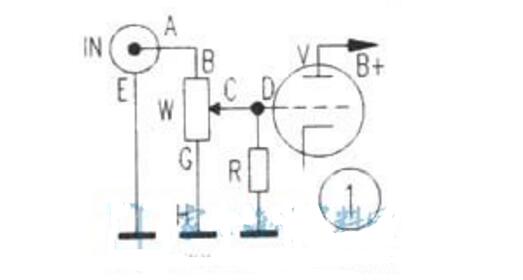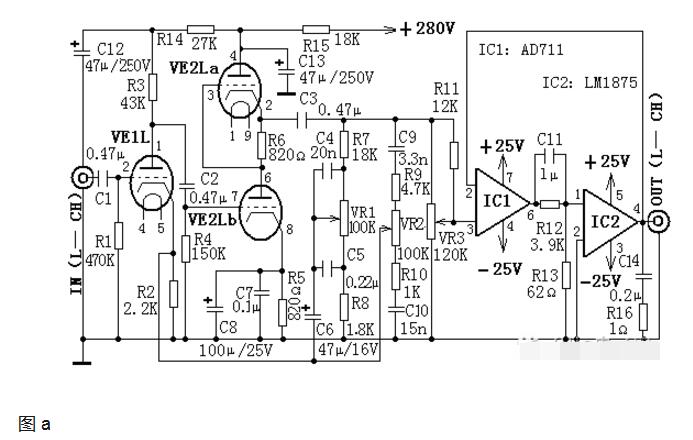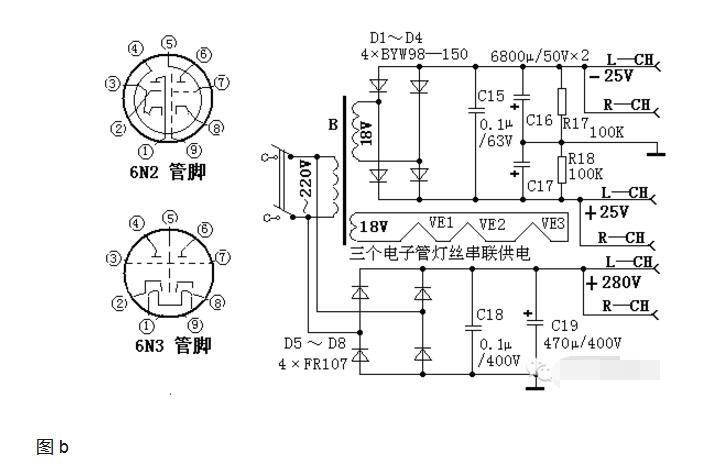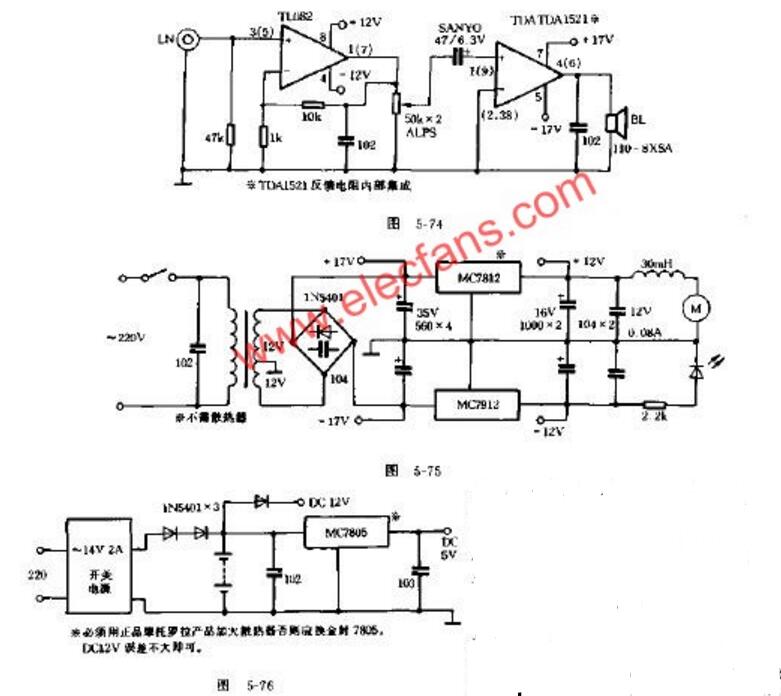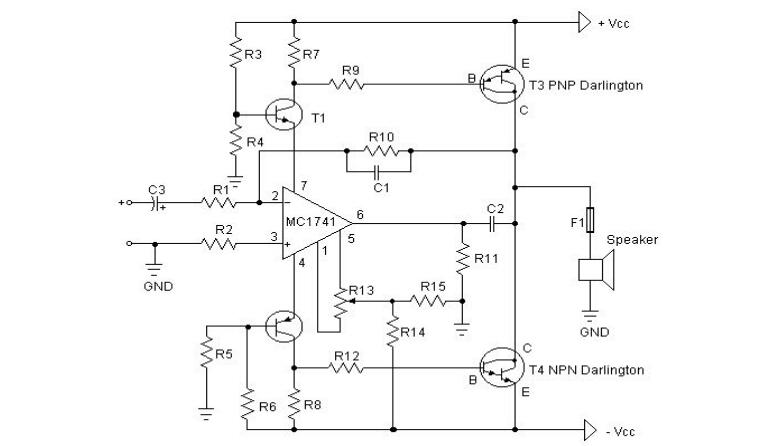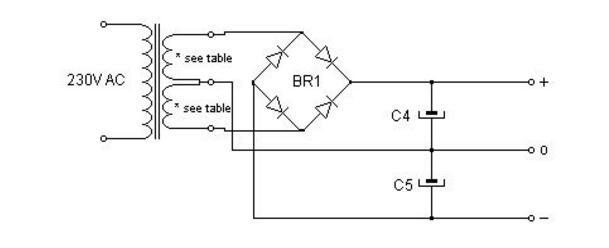25W Hybrid Hi-Fi Amplifier with Tone Control (Four HI-FI Power Amplifier Circuits)
Hi-Fi is the abbreviation of English High-Fidelity, which means high-fidelity meaning, which means to restore the sound source information realistically, that is, the original taste. It requires the audio equipment to zoom in and process the various indicators of the sound signal without distortion during the playback process, in order to restore the original appearance of the sound source, emphasizing the original taste, mostly used to enjoy music. Hi-Fi amplifiers are signal amplifiers designed to reproduce the true colors of music with high fidelity. 1. AV power is insufficient when playing a large signal source. This can be seen from the product manual. The output power of the AV amplifier in the two-channel state is larger than that in the four-channel state. However, some manufacturers' specifications are the same. At this time, you can use a large dynamic range of music to audition, you can obviously feel powerless. This is because the total power consumption of the AV amplifier is large, the power supply reserves are not surplus, and the Hi-Fi amplifier is calm. 2, AV amplifier wiring affects sound quality The AV amplifier sets a variety of video and audio ports, and accesses multiple sets of audio and video signal sources, resulting in many and complicated signal lines, which easily cause mutual interference of signals. In particular, the existence of distributed capacitance has the greatest influence on high-frequency audio and its harmonics, so that the original high-frequency components of the high-quality signal source are attenuated or interfered, so that the listener can not appreciate the high-fidelity effect. 3, the screen of the AV amplifier will also interfere with the sound quality AV power amplifier pays attention to convenient multi-function operation. The panel is equipped with a large-scale fluorescent display, which makes the operation intuitive and vivid. However, the fluorescent screen is heated by low-voltage AC filament, and the character display is driven by the pulse signal, which will radiate a lot of electromagnetic interference to the surrounding. Affect the sound quality. If you want to enjoy movies and TV shows, then choose AV amplifiers, if you have a soft spot for music, then choose Hi-Fi amplifier. The input part of the Hi-Fi amplifier (taking the amplifier as an example) refers to a signal transmission line from the input RCA socket to the volume potentiometer to the gate of the input stage voltage amplifier tube (see Figure 1). Generally, they are connected by coaxial signal lines (shielded wires), and are commonly used in the class of enthusiast grades, even silver wires. However, it is usually only concerned with the two lines of the volume potentiometer, such as the AB and CD lines as shown in Fig. 1. Input the EF line of the negative end of the RCA socket to the ground, the GH line of the ground potentiometer to the ground of the volume potentiometer, generally use ordinary copper wire, even copper wire with very small diameter, and some due to the distance between F and H It is very long and may be connected through a metal chassis. This connection method, although the amplifier can work normally, and even the sound effect is ok, but this connection is asymmetric and unbalanced for the signal in and out paths (positive and negative half cycles of the signal). It will have a certain impact on the speed, rhythm, details and positioning of music. If the signal loop is balanced and symmetrical, the playback effect will be greatly improved, especially the high frequency performance is particularly prominent. The reason is very simple, because the signal needs a smooth loop during transmission. The wires of the positive and negative half-cycles are different. The thickness is different and the length is different. The resistance and distribution capacitance are different, the loss is different, and the sound performance is different. It will be affected. Therefore, in order to make the amplifier have more beautiful sound performance, it should be improved by using the wire and the connection method. The improvement method is very simple, as shown in Figure 2, connect the negative end of the RCA socket to the ground of the volume potentiometer (no longer through the ground), and the positive and negative ends to the volume potentiometer two lines - - That is, A to B are equal to E to G, each using the same material, the same wire diameter, and the same length of the coaxial signal line. The shield layer is grounded only at one end. If the line segment CD is short, the shielded wire can be omitted. However, the material of the wire should be the same as that used for the segment AB, and the length of the two channels is equal, and the line is balanced and symmetrical. The bulk signal line on the market has two cores and three cores. Each channel can be used with a two-core, one core connected to A to B, one core connected to E to G, and the shield layer can be grounded. The three-core signal line can also be used. The extra core is grounded together with the shield layer. It is not allowed to use one loop for one core, one loop for two cores, or one loop for each core, and the other core is empty. Ground. It is better to use a small signal line of two cores or three cores, because the two core or three core wires are gently twisted in the shielding layer, which can cancel the magnetic lines of force and is beneficial to the brightness of the middle and high notes. If a single-core coaxial signal cable is used, the two should be twisted gently, but do not twist too tightly. A symmetrical, balanced signal input circuit that makes the music more perfect. If you are using a bile preamp or amplifier, you will input the grounding cable of the RCA socket, volume potentiometer, etc., and replace it with the same material, length, and wire diameter as the signal terminal, and then you may hear it. Different, more beautiful sounds. The amplifier is used as the front stage of the electron tube, and the audio dedicated integrated circuits AD711 and LM1875 are used as the rear stage. The circuit distortion is small, the output impedance is low, and the dynamic range is large, which can ensure good sound quality. This circuit only draws the left channel part, the right channel is slightly. The circuit uses a double three-pole 6N2 type tube to form a line input amplifier (half of the 6N2 VE1L for the left channel and the other half for the VE1R for the right channel). R2 is the DC bias resistance of the input stage. When the screen current Iao flows through R2, a DC voltage Eg of about 1.5V is generated, which is applied to the gate of VE1L through the gate leakage resistor R1 to form the negative gate voltage of the line amplifier. At this time, VE1L works in Class A state and has good linearity. Another function of R2 is to generate appropriate AC feedback to the source signal, which further reduces the distortion and further improves the stability; the third function of R2 is to form the tone feedback. This input stage has the outstanding advantages of high input impedance of hundreds of kiloohms, large dynamic range, and good transient response, which is necessary for the Hi-Fi preamp. An attenuated tone control network (TCN) is placed between the front and rear stages. The audio signal output from the VE2La cathode K on the SRPP circuit is sent to the 3 pin of the post-stage integrated circuit IC1 via the volume potentiometer VR3; the other path is fed to the cathode of the line amplifier VE1L via the TCN network. This combination can effectively suppress the noise and distortion while maintaining the adjustment characteristics of the attenuated TCN. The signal is amplified from VE1L and output from the anode. It is coupled via capacitor C2 to a power amplifier exciter VE2 consisting of an electron tube 6N3 with excellent high frequency characteristics. The two internal transistors are connected in parallel to adjust the push-pull circuit SRPP. The circuit is characterized by low distortion, low output impedance, and large dynamic range, and is fully adapted to various power amplifiers composed of IC, FET, TR, VAL, and the like. In Figure (a), capacitors C4, C5, resistors R7, R8, and potentiometer VR1 form a low-pitched control network. When VR1 is adjusted up, the negative feedback amount of the network composed of C5 and C4 to the low audio signal increases, and the bass is relatively weakened; otherwise, the bass is relatively enhanced when VR1 is adjusted down. Capacitors C9, C10, resistors R9, R10 and potentiometer VR2 form a high-pitched control network. When VR2 is adjusted up, the negative feedback amount of the high audio signal increases, and the high sound is relatively weakened; otherwise, the high pitch is relatively enhanced when VR2 is adjusted downward. In the power amplifier circuit, it is desirable to obtain high fidelity and high power output. It is not difficult for a general power amplifier to provide a large power for the load, but most of them have the disadvantages of large distortion and linearity difference. If a precision op amp IC1 with good linearity and low distortion is inserted into the front end of the high-power IC, so that the power amplifier IC2 is in the feedback link of IC1, the effect of lengthening and avoiding shortness can be achieved. This type of connection is called a "turbocharged combination" (TCC). Integrated circuit IC1 (AD711) and IC2 (LM1875) form the rear stage of TCC power amplifier. In the TCC network, C11, R12 and R13 form an RC network, which provides moderate phase compensation for the audio signal, which makes the frequency response area of ​​IC1 and IC2 stable. Figure (b) is the power supply circuit diagram of the whole machine. The high voltage of the pre-stage of the electron tube is directly provided by the mains rectification to generate 280V DC power. The three filaments of the two electron tubes are connected in series, and a set of AC 18V power supply makes the circuit much simple. The other group of AC 18V is bridged rectified, C15, C16, C17, and filtered to generate ±25V for IC1 and IC2. Tube VE1 selects 6N2, VE2 selects 6N3, integrated circuit IC1 selects AD711, IC2 selects LM1875, low-voltage filter capacitor C16, C17 selects 70VW series, high-voltage filter capacitor C19 selects CD17H series, C15 selects polyester capacitor, C18 selects polypropylene capacitor, C6, C8 selects tantalum electrolytic capacitor, C12, C13 selects CD03HV high voltage electrolytic capacitor. All resistors are made of metal film series. Potentiometers use the KK210 series. Component parameters are selected based on the circuit icon note. Select components and install them correctly, you can succeed once, no need to debug. The tube should be installed with an electronic tube holder. The integrated circuit should be kept away from the tube as much as possible to avoid overheating of the integrated circuit. After the circuit is installed, it should be installed in a chassis with cooling holes, and the volume potentiometer and high and low potentiometers are placed on the chassis panel for easy adjustment. STK2100-2 is a high-power amplifier integrated circuit with a fever level. Its output uses a power FET with electron tube characteristics. The output power is 100W*2, the frequency response is 10HZ~20KHZ, and the working voltage of the circuit is at least plus or minus 12V. Positive and negative 50V, distortion is 0.01%. It uses its high-quality power amplifier to make its peripheral circuits very simple, with small distortion, and the parameters such as frequency band and output power have reached excellent indicators. The circuit is shown in Figure 5-84. VD3 is the speaker bridge pickup circuit. When the power amplifier circuit is normal, RL only has AC signal and no DC voltage, and the pickup circuit does not work. VT1 cut-off, VT2, VT3 turn on, K pull-in, the amplifier output turns on the speaker. When the circuit fails, VT1 is turned on, VT2, VT3 is cut off, K is released, and the speaker is effectively protected. ICI is a low-noise, high-conversion rate operational amplifier NE5535 with a fever level. The NE5535 output circuit is a PNP-NPN fully symmetrical complementary structure with a certain quiescent current bias and a very simple internal circuit. It has the advantages of open loop frequency response, high unity gain bandwidth, high slew rate, small open loop distortion, low noise and good transient characteristics. It is an ideal chip for HiFi audio preamplifier and is used by Puzhi. For the barrier of the op amp. This circuit power transformer uses 250W ring type "Fire Bull", the power amplifier and the front power supply are separately supplied with power, and the high-quality high-capacity electrolytic capacitor is selected, so the reserve power is large enough. All resistors in the circuit are high quality metal film resistors. The capacitor is selected from é’½ and CBB capacitors. Therefore, the sound of the whole machine is small, the midrange is bright and clear, the bass is strong and thick, and it has the flavor of "biliary" machine. The self-made power amplifiers are TL082 and TDA1521. The circuit is shown in Figure 5-74 and Figure 5-75. The power supply voltage of the machine should not be higher than the double 14V, but the power should not be lower than 20W. The dual 12VE type transformer is used, and the resistors are all 1/4W5 ring gold film. The capacitor is made of domestic monolith and deep fiber. The input of TDA1521 adopts SANYO's 47pF/6. 3V organic solid capacitor, and 560pF/35V electrolysis is the common product of ELNA. There are several imported capacitors here, which are related to sound quality and should not be sloppy, but the price is higher. The amplifier uses a 486 cooling fan for heat dissipation, which basically has no interference noise. The sound is made by fixing the two southern whale YD-110-8SXA speakers with the plastic case of the speaker on the car. The frequency is 80~ 10000Hz. The real frequency is not deep but the response is fast and accurate, and the vocals are good. In fact, the instrument pitch is not much higher than 8000Hz. Trying to put Tchaikovsky's No. ~ Steel Spear Syndrome "81812", I feel that the piano sound is more accurate in most cases. The brass instrument can make you feel brilliant, the sound of the gun can not be said, the sound pressure The level is not big, but it is very clear. The connection uses 30 yuan "gold and silver" line of 1 yuan / meter. This speaker is the largest of the 4" magnets, similar to some 6.5-inch magnets, and has a shield for center or mains. The power supply adopts “UPSâ€, a 14V/2A switching power supply generates all voltages, and the battery is powered by power failure (lights out). The circuit is shown in Figure 5-76. The battery capacity cannot be lower than 4Ah. The fan blows, and a small light bulb reads a book. Note: - The first thing you should do is test the amplification factor hfe or β of the final power tube. If their difference is greater than 30%, the amplifier will not give you a clear sound, I use the MJ3001 and MJ2501 transistors, and their difference is 5%. Before turning on the power, you must short-circuit the input, string an ammeter at the output of the amplifier, then turn on the power, adjust R13 to make the ammeter current to microampere level, if you are lucky enough, you can reach 0, the ammeter current is 10 micro Ampere is very easy to do. Power amplifier circuit diagram: Power circuit: The amplifier uses the commonly used TDA2822 small power amplifier block (which is very easy to buy on the market). The TDA2822 is an 8-pin dual-inline plastic package integrated block with small size and large output power. No need to add a radiator. The whole circuit components are few, the power supply voltage is 2V ~ 15V DC, the quiescent current and distortion are very small, can work in stereo state, can also work in BTL state. The circuit principle is shown in the attached drawing. All the components used in the figure are common components, the resistor is 1/4W, and the capacitor withstand voltage is 25V. This circuit is a two-channel circuit, Cl and C2 are coupling capacitors, which function as DC blocking, C3 is the power supply filter capacitor, C4 and C5 are output coupling capacitors, Rl and R2 are bias resistors, and R3, R4, C6, C7 function. Is to prevent self-excitation. This circuit uses 3V DC power supply. If there are conditions, higher voltage can be used to increase the output power, but the maximum is not higher than 15V. The speaker is 8Ω1W or 4Ω2W, and the larger the diameter, the better. Open Frame For Capacitive Touch All-in-one ShenZhen GreenTouch Technology Co.,Ltd , https://www.bbstouch.com